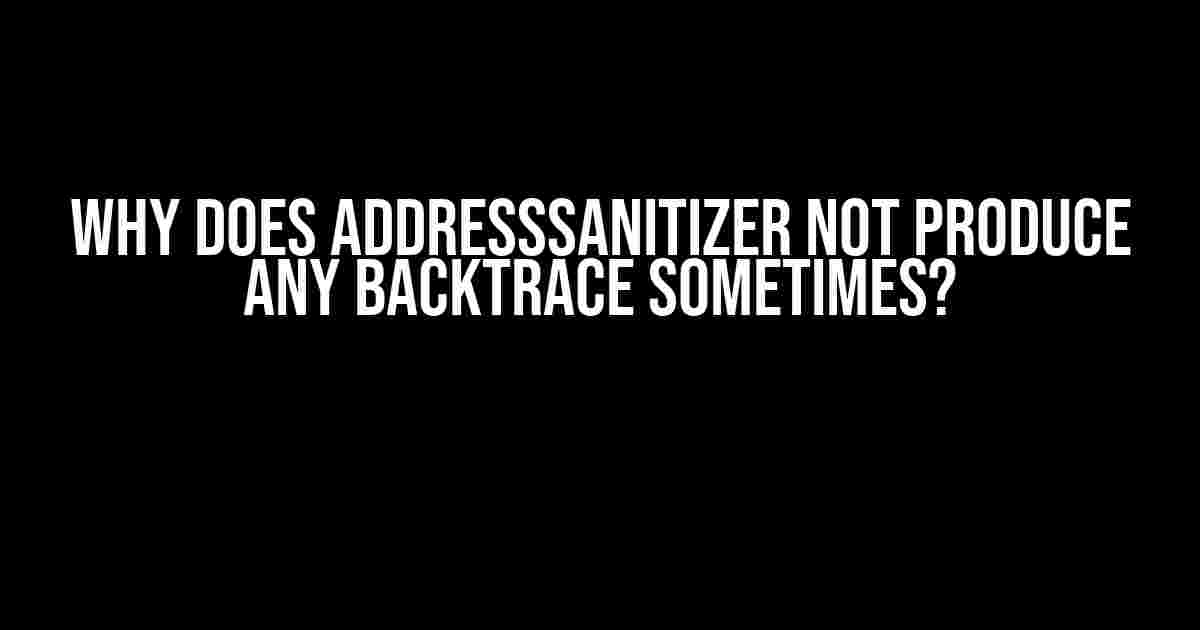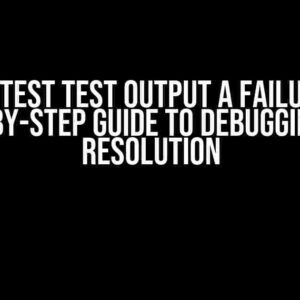AddressSanitizer (ASan) is an incredible tool for detecting memory errors in C/C++ applications. It’s a game-changer for developers who want to ensure their code is stable and secure. However, sometimes, ASan can be frustratingly quiet, leaving you wondering, “Why does AddressSanitizer not produce any backtrace sometimes?”
The Mysterious Case of the Missing Backtrace
Before we dive into the reasons behind ASan’s occasional silence, let’s set the stage. Imagine you’ve written a C++ program, and you’re testing it with ASan enabled. Suddenly, your program crashes, and you’re expecting ASan to provide a detailed backtrace, pointing you to the exact line of code causing the issue. But, to your surprise, the backtrace is missing or incomplete.
This can be frustrating, especially when you’re relying on ASan to help you identify and fix memory-related issues. Don’t worry; we’re about to explore the common reasons behind this phenomenon.
Reason 1: ASan’s Detection Heuristics
ASan uses various heuristics to detect memory errors. These heuristics can sometimes lead to false negatives, where ASan fails to report an error or provide a backtrace. There are a few reasons why this might happen:
- Shadow memory: ASan maintains a shadow memory region that tracks the state of your program’s memory. If the error occurs in a region not covered by the shadow memory, ASan might not detect it.
- Error classification: ASan classifies errors into different categories, such as use-after-free, invalid reads, or invalid writes. If the error doesn’t fit into one of these categories, ASan might not report it.
- Thresholds and timeouts: ASan has built-in thresholds and timeouts to prevent it from reporting too many errors or getting stuck in an infinite loop. If your program triggers an error that exceeds these thresholds, ASan might not report it.
These heuristics are essential to ASan’s performance and accuracy, but they can sometimes lead to false negatives.
Reason 2: Compiler Optimizations
Compiler optimizations can sometimes interfere with ASan’s ability to produce a backtrace. Here are a few reasons why:
- Dead code elimination: The compiler might eliminate code that it considers dead or unreachable, which can lead to ASan missing the error.
- Inlining and tail call optimization: Compiler optimizations like inlining and tail call optimization can modify the call stack, making it difficult for ASan to reconstruct the backtrace.
- Register allocation and spilling: The compiler’s register allocation and spilling decisions can affect the accuracy of ASan’s backtraces.
These compiler optimizations can be tweaked or disabled to improve ASan’s accuracy, but this might come at the cost of performance.
Reason 3: Hardware and System Factors
Hardware and system factors can also contribute to ASan’s occasional silence:
- Page faults and TLB misses: Page faults and TLB (Translation Lookaside Buffer) misses can lead to errors that ASan can’t detect or report accurately.
- System calls and signal handling: System calls and signal handling can interrupt ASan’s detection mechanisms, causing it to miss errors or produce incomplete backtraces.
- Resource constraints: Resource constraints, such as low memory or high system load, can affect ASan’s performance and accuracy.
These hardware and system factors can be challenging to overcome, but understanding them is crucial for effective use of ASan.
Reason 4: ASan Configuration and Setup
Incorrect or incomplete ASan configuration and setup can also lead to missing backtraces:
- asanoptions: Incorrect or missing asanoptions can affect ASan’s detection and reporting capabilities.
- Library and framework interference: Interference from libraries or frameworks can disrupt ASan’s operation, leading to missing backtraces.
- Custom allocators and memory management: Custom allocators and memory management implementations can interfere with ASan’s ability to detect and report errors.
Double-checking your ASan configuration and setup can help you identify and resolve issues related to missing backtraces.
What Can You Do About It?
Now that we’ve explored the common reasons behind ASan’s occasional silence, it’s time to discuss what you can do to improve the situation:
1. Enable verbose mode
ASAN_OPTIONS=verbosity=1 ./your_program
Enabling verbose mode can provide more detailed information about ASan’s internal workings and error detection.
2. Increase the error reporting limit
ASAN_OPTIONS=error_limit=100 ./your_program
Increasing the error reporting limit can help ASan detect more errors and provide more backtraces.
3. Disable compiler optimizations
gcc -O0 -g -fsanitize=address your_program.c
Disabling compiler optimizations can improve ASan’s accuracy, but this may come at the cost of performance.
4. Use alternative sanitizers
Other sanitizers like UBSan (Undefined Behavior Sanitizer) or MSan (Memory Sanitizer) might be more effective in detecting specific types of errors.
5. Analyze core dumps and crash reports
Examining core dumps and crash reports can provide valuable insights into the error and help you identify the root cause.
6. Review your code and data structures
Thoroughly reviewing your code and data structures can help you identify potential memory-related issues and improve the overall quality of your code.
Conclusion
In conclusion, ASan’s occasional silence can be frustrating, but understanding the reasons behind it can help you overcome these issues. By enabling verbose mode, increasing the error reporting limit, disabling compiler optimizations, using alternative sanitizers, analyzing core dumps, and reviewing your code and data structures, you can improve the effectiveness of ASan and ensure your C/C++ applications are stable and secure.
Remember, ASan is a powerful tool, and with the right approach, it can help you write better code and catch those pesky memory errors.
| Reason | Description |
|---|---|
| ASan’s Detection Heuristics | Shadow memory, error classification, and thresholds can lead to false negatives. |
| Compiler Optimizations | Dead code elimination, inlining, and register allocation can interfere with ASan. |
| Hardware and System Factors | Page faults, TLB misses, system calls, and resource constraints can affect ASan. |
| ASan Configuration and Setup | Incorrect asanoptions, library interference, and custom allocators can disrupt ASan. |
Further Reading
Want to learn more about AddressSanitizer and how to get the most out of it? Check out these resources:
Stay tuned for more articles on memory safety, AddressSanitizer, and C/C++ development!
Frequently Asked Question
AddressSanitizer is a powerful tool for detecting memory corruption bugs, but sometimes it can be frustratingly silent when we need it to speak up! Here are some answers to common questions about why AddressSanitizer might not produce a backtrace.
Why doesn’t AddressSanitizer produce a backtrace when I deliberately write to freed memory?
Hey there, rebel developer! It’s because AddressSanitizer only detects invalid accesses to memory regions that are still being tracked by the allocator. When you free memory, those regions are removed from tracking, and ASan won’t detect accesses to them anymore. Try using a different memory-corrupting technique, like writing to an uninitialized variable or array indexing out-of-bounds, and ASan should produce a backtrace.
What if I’m using a custom allocator that doesn’t play nice with AddressSanitizer?
Ah, custom allocator adventures! In that case, the issue might be that your custom allocator isn’t correctly interacting with AddressSanitizer’s instrumentation. Check if your allocator is correctly annotated with the `__attribute__((no_sanitize(“address”)))` attribute, and make sure it’s not hiding memory regions from ASan. You might need to tweak your allocator to work nicely with ASan, or consider using a different allocator that’s ASan-friendly.
Could it be because I’m using AddressSanitizer on an old/different architecture or OS?
Good thinking, detective! Yes, AddressSanitizer’s behavior can vary across different architectures, OSes, or even compiler versions. For example, some platforms might not support certain features, like shadow memory or aborting on error. If you’re experiencing issues, try reproducing the problem on a different platform or environment to isolate the issue. You can also check the ASan documentation for platform-specific limitations or known issues.
What if I’m using a sanitizer-agnostic code, but still not getting a backtrace?
Hmmm, that’s a tricky one! In this case, the issue might be that your code is using a mechanism that bypasses AddressSanitizer’s instrumentation. This could be due to inline assembly, using libraries that disable sanitizers, or even some compiler optimizations. Try to identify the specific piece of code that’s causing the issue and see if you can refactor it to make it sanitizer-friendly. You can also try using other sanitizers, like MemorySanitizer or UndefinedBehaviorSanitizer, to see if they catch the error.
Are there any performance-oriented compiler flags that could disable AddressSanitizer?
Ah, performance tweaking gone wrong! Yes, some compiler flags can interfere with AddressSanitizer’s functionality. For example, the `-fomit-frame-pointer` flag on GCC or `-O2` on Clang can disable frame pointer-based unwinding, which ASan relies on. Double-check your compiler flags and make sure you’re not accidentally disabling ASan. You can also try building your code with the `-fsanitize-recover` flag to enable error recovery and see if it produces a backtrace.


